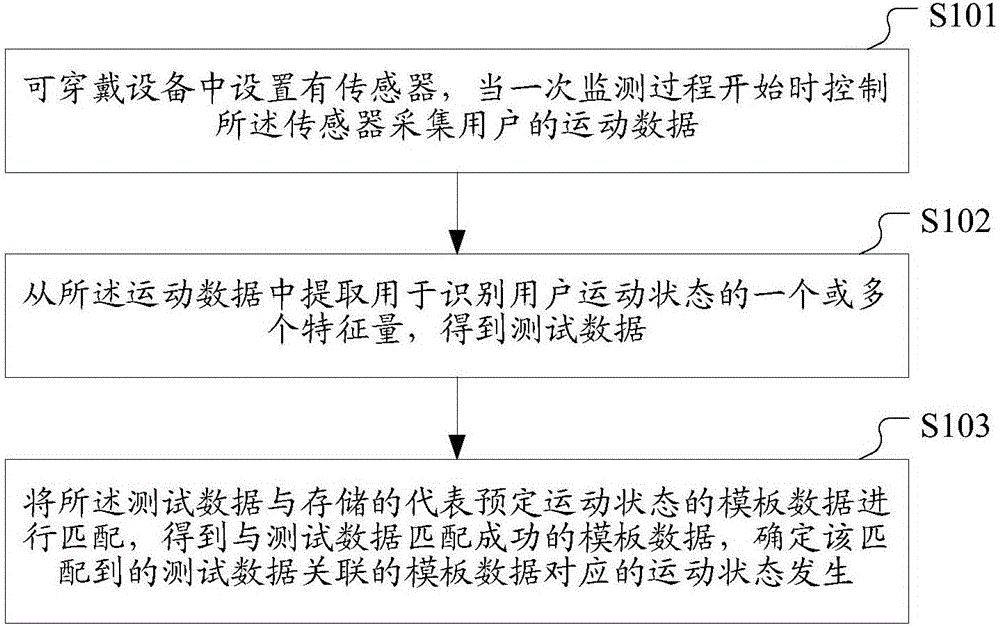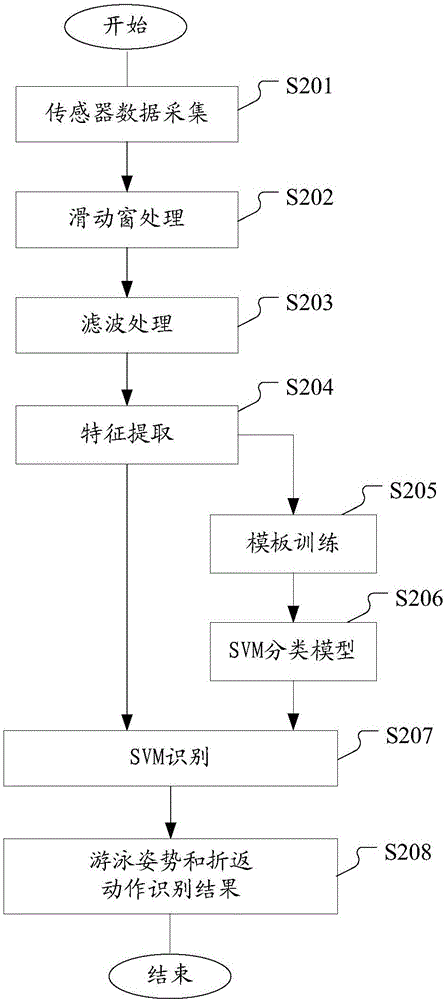Wearable device and method adopting same to monitor motion state
A wearable device and motion state technology, applied in sports accessories, applications, swimming, etc., can solve the problems of poor portability, inability to meet the swimming state monitoring requirements, low accuracy, etc., to achieve easy portability, improve market competitiveness, and accurate high degree of effect
- Summary
- Abstract
- Description
- Claims
- Application Information
AI Technical Summary
Problems solved by technology
Method used
Image
Examples
Embodiment 1
[0035] figure 1 It is a flow chart of a method for monitoring exercise status using a wearable device according to an embodiment of the present invention, see figure 1 , the wearable device is provided with a sensor, and the method includes the following steps:
[0036] Step S101, when a monitoring process starts, control the sensor to collect the user's motion data;
[0037] Step S102, extracting one or more feature quantities used to identify the user's exercise state from the exercise data to obtain test data;
[0038] Step S103: Match the test data with the stored template data representing the predetermined motion state to obtain template data that successfully matches the test data, and determine that the motion state corresponding to the template data associated with the matched test data occurs.
[0039] The above steps S101 to S103 may be implemented by functional modules provided in the wearable device.
[0040] Depend on figure 1From the method shown, it can be ...
Embodiment 2
[0047] figure 2 It is a flow chart of a method for monitoring exercise status using a wearable device according to another embodiment of the present invention, see figure 2 , the overall flow of the method of using wearable devices to monitor the state of exercise is as follows: firstly, the four basic swimming postures are recognized, and at the same time, the occurrence of reentry movements can also be recognized. It mainly adopts motion state monitoring and recognition based on time-domain features and support vector machine (SVM). Secondly, for the three-axis acceleration data collected during swimming, the sliding window processing method is adopted, and there must be a certain overlap between adjacent sliding windows. For the X, Y, Z three-axis acceleration data in the sliding window, the sliding mean filter is used to remove the influence of noise and obtain relatively smooth data. Then, in each sliding window, temporal features are extracted separately. Finally, s...
Embodiment 3
[0087] The method of using the smart watch to monitor the state of swimming in this embodiment specifically includes the following steps:
[0088] Step 31, the sensor collects data
[0089] The built-in acceleration sensor of the smart watch is used, and the collected data is the X, Y, and Z three-axis acceleration of the swimming action. The collected data are respectively stored in the ring buffer (ring buffer) whose length is Len, such as image 3 shown.
[0090] Step 32, sliding window processing.
[0091] Add sliding windows to the three-axis acceleration data taken from the ring buffer, such as Figure 4 shown. The size of each window is N samples, the covered time length is T seconds, and the moving step of the sliding window is step samples (step size=N / 2 can be taken, that is, adjacent windows overlap by half the window length). Subsequently, filter processing is performed on the data of each window.
[0092] The purpose of sliding window processing: sliding win...
PUM
 Login to View More
Login to View More Abstract
Description
Claims
Application Information
 Login to View More
Login to View More - R&D
- Intellectual Property
- Life Sciences
- Materials
- Tech Scout
- Unparalleled Data Quality
- Higher Quality Content
- 60% Fewer Hallucinations
Browse by: Latest US Patents, China's latest patents, Technical Efficacy Thesaurus, Application Domain, Technology Topic, Popular Technical Reports.
© 2025 PatSnap. All rights reserved.Legal|Privacy policy|Modern Slavery Act Transparency Statement|Sitemap|About US| Contact US: help@patsnap.com



